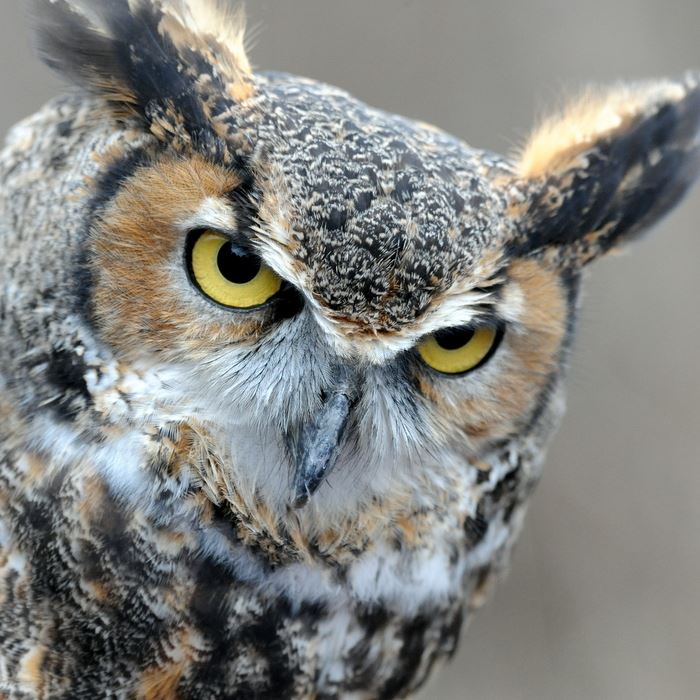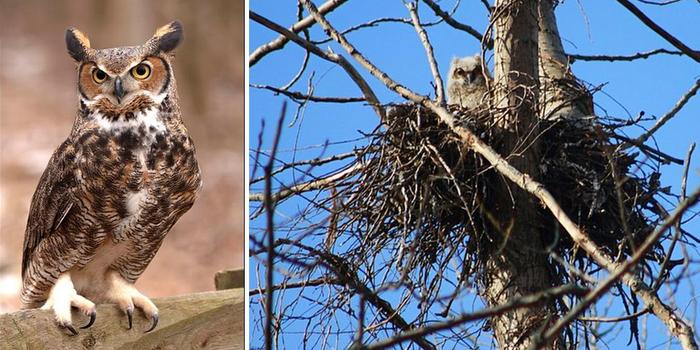Whooo’s Nesting?

By Karen Menard
The “Tiger of the Woods,” more commonly known as the great-horned owl, is our earliest nesting bird in Ohio. Measuring approximately 20-25 inches tall (the female larger than the male), with a wingspan of about 5 feet, it is also Ohio’s largest resident owl and one very fierce predator.
Stalking the edges of woodlots adjacent to open areas, wetlands and even suburban sites, many of these large birds may choose to take ownership of an old red-tailed hawk, crow or bald eagle nest in late January or February. Others will choose to rear their young in a broken tree snag or inside a large tree cavity.
With ferocity, these animals brave the bitter winter elements, laying a fragile clutch of 2 to 4 eggs then incubating them for about a month. Sitting on the nest for extended periods of time, the bird is often covered in snow, yet very well adapted to the cold temperatures. Great-horned Owls are well suited, with insulating feathers that aid in keeping the eggs at or near a balmy 98 degrees Fahrenheit. These tough animals will brave the wind, cold and stormy weather 40-70 feet up in a tree!
After the eggs hatch, the young birds are fed a diverse variety of prey items that include rabbits, rodents, skunks and other medium-sized mammals and birds captured in the grip of very strong talons.
At 6 to 7 weeks old, the owlets are more easily seen as they start roaming out of the nest onto branches. The birds cannot fly well until 9 to 10 weeks, so if their hatch date was mid-March, they would be ready to fly in May or June. Other young animals are also very abundant at this time of year, so the timing works in the owls’ favor, as the young birds will have no problem finding prey.
How to Spot A Great-horned Owl
In the Metroparks, great-horned owls have been recorded at Pearson, Swan Creek Preserve, Fallen Timbers, Side Cut, Wildwood Preserve, Secor and Oak Openings Preserve.
When looking for great-horned owls, remember that their feather coloration and pattern keeps them well camouflaged. Their brown feathers easily blend in with tree trunks, keeping them out of sight of raucous mobs of crows and jays.
Viewing one of these nocturnal owls during the daylight hours can be difficult at any time of year, but in February and March you may get a glimpse of them sitting low in the nest on eggs. Look for a mass-like, stick nest in the crown of taller trees. At a safe distance with binoculars or a scope, check for the top of a head and ear tufts. After dark, listen for their loud call – “hoo-hoo-hoo---hooo…hooo.” This sound can often be heard for up to a mile. If they feel threatened, they may hiss, scream or clap their beak loudly.
Raptor nests and individual bird sightings have been monitored by volunteers at Wildwood, Secor and Oak Openings since 2006 as part of an annual Oak Openings Region breeding raptor study. The study has confirmed nesting in Oak Openings and Wildwood.
As predators at the top of the food chain, owls and other raptors are critical to helping maintain a balance within functioning ecosystems in the Metroparks and throughout the region. They play an important ecological role in our region’s habitats.

Photo Credits: Top, Art Weber; Center, Bob Jacksy, Sue Anderson; above, Jon Zabowski
